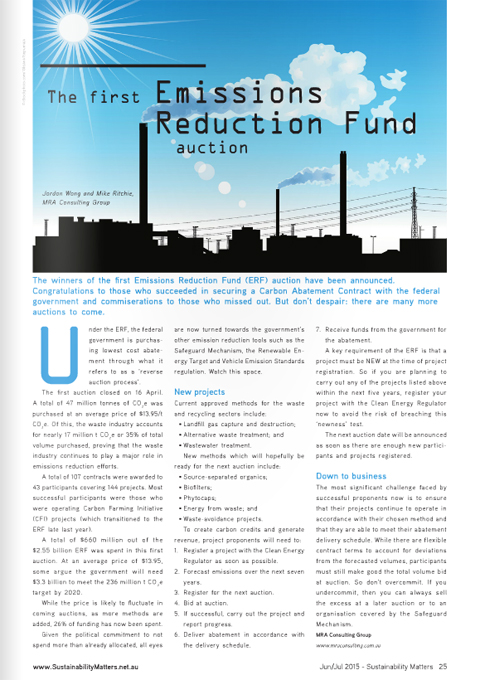Lessons from the first ERF carbon auction
 Published by ResourceRecovery.biz
Published by ResourceRecovery.biz
The winners during the first Emissions Reduction Fund (ERF) auction have been announced. Congratulations to those who succeeded in securing a Carbon Abatement Contract with the Federal Government and commiserations to those who missed out. But don’t despair: there are many more auctions to come.
Under the ERF, the Federal Government is purchasing lowest cost abatement through what they refer to as “reverse auction process”.
The first auction closed on Thursday 16th April. A total of 47 million tonnes of CO2-e was purchased at an average price of $13.95 per t CO2e. Of this, the waste industry accounts for nearly 17 million t CO2e or 35% of total volume purchased, proving that the waste industry continues to play a major role in emissions reduction efforts.
A total of 107 contracts were awarded to 43 participants covering 144 projects. Most successful participants were those who were operating Carbon Farming Initiative (CFI) projects (which transitioned to the ERF late last year).
A total of $660 million out of the $2.55 billion ERF was spent in this first auction. At an average price of $13.95, some argue the government will need $3.3 billion to meet the 236 million t CO2e target by 2020.
While the price is likely to fluctuate in coming auctions, as more methods are added, 26% of funding has now been spent.
Given the political commitment to not spend more than already allocated, all eyes are now turned towards the Government’s other emission reduction tools such as the Safeguard Mechanism, the Renewable Energy Target, and Vehicle Emission Standards regulation. Watch this space.
New projects
Current approved methods for the waste and recycling sectors include:
- Landfill gas capture and destruction
- Alternative Waste Treatment; and
- Wastewater treatment.
New methods which will hopefully be ready for the next auction include:
- Source Separated Organics,
- Biofilters,
- Phytocaps,
- Energy from waste and
- Waste avoidance projects.
To create carbon credits and generate revenue, project proponents will need to:
- Register a project with the Clean Energy Regulator as soon as possible
- Forecast emissions over the next 7 years
- Register for the next auction
- Bid at auction
- If successful, carry out the project, and report progress
- Deliver abatement in accordance with the delivery schedule
- Receive funds from the government for the abatement.
A key requirement of the ERF is that a project must be NEW at the time of project registration. So if you are planning to carry out any of the projects listed above within the next 5 years, register your project with the Clean Energy Regulator now to avoid the risk of breaching this “newness” test.
The next auction date will be announced as soon as there are enough new participants and projects registered.
Down to business
The most significant challenge faced by successful proponents now is to ensure that their projects continue to operate in accordance with their chosen Method and that they are able to meet their abatement delivery schedule. While there are flexible contract terms to account for deviations from the forecasted volumes, participants must still make good the total volume bid at auction. So don’t over commit. If you under-commit, then you can always sell the excess at a later auction or to an organisation covered by the Safeguard Mechanism.
If you would like further information, please contact Jordon Wong (Jordon@mraconsulting.com.au) or Mike Ritchie (mike@mraconsulting.com.au)




